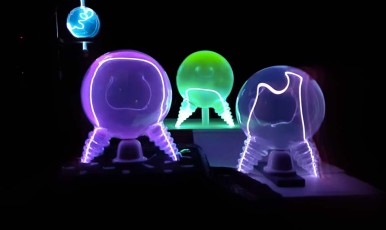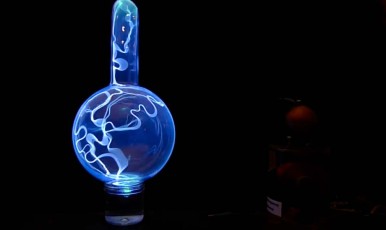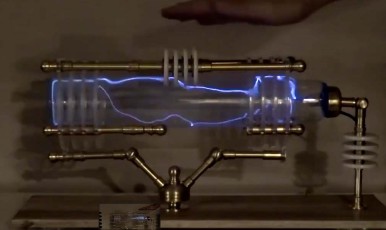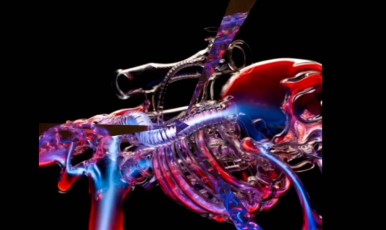
Aaron Ristau Art
Aaron Ristau Art @ Loveland, Colorado Feed and Grain Loveland June 2012

3 pole piglets by Aaron Ristau

Decorative xenon plasmas by Carl Willis
Four 500-ml borosilicate Florence flasks are filled with xenon at various pressures between 20 and 80 torr (mmHg) and sealed off without any electrodes penetrating the glass. In the video (after an intro featuring a large 1-liter flask at 50 torr) I show these low-pressure gas volumes being excited by high-frequency (5-50 kHz), high-voltage (~5-30 kV) current capacitively coupled into the flask via a cup of tapwater in which the flask rests. At the lowest pressure (20 torr), xenon exhibits a diffuse, emerald-green glow that fills most of the volume but isn't particularly dynamic. Even lower pressures result in similar discharges that are increasingly dim as the pressure is reduced. At the highest pressure shown (80 torr), the electrodeless discharge becomes challenging to strike, but it has frenetic dynamics, sensitive touch response, and great contrast between diffuse green elements and brilliant-white filamentary arcs. The other two flasks show intermediate pressures at 40 and 60 torr. If I had to recommend a favorite, it would be the 40-torr effect. As always, questions and comments are appreciated!

Plasma tubes containing neon mixtures by Carl Willis
Five electrodeless discharge tubes containing neon as the principal ingredient are demonstrated and discussed. A high-frequency, high-voltage power supply is used to excite the gas. Electrical breakdown in neon emits an iconic red color under the low-pressure conditions found in neon signs, but at the high pressures of interest in much plasma sculpture, it is more difficult to coax beautiful effects from this gas. Its low atomic weight means it is efficient at dissipating heat by diffusion, making it reluctant to form filamentary discharges like xenon and krypton; furthermore, its characteristic red emissions are washed out in high pressure glows. So, to produce vibrant colors and filamentary arcs, the neon is "doped" with small amounts of other gases and vapors. I show what obtains when neon is doped with (1) nitrogen; (2) oxygen and krypton; (3) 1-bromo-3-chloro-5,5-dimethylhydantoin (BCDMH); (4) iodine; and (5) xenon, nitrogen, and oxygen.

Xenon and neon kinetic light sculpture by Aaron Ristau

State of the Art studio by Aaron Ristau
August 2018 State of the Art studio by Aaron Ristau

Bernd-bong-neon

Pangea Planets by Bernd Weinmayer and Gerhard Hochmuth

PANGEA PLASMA PLANET by Gerhard Hochmuth

Ray Machine by Bernd Weinmayer

The Ray Hammer by Bernd Weinmayer

Plasma tube by Pierre-Jean Tardiveau
Plasma tube "Metropolis IV" by Pierre-Jean Tardiveau

Electrical discharges in xenon by Carl Willis
Xenon is beloved by plasma artists for its vivid white arcs. It is the main constituent gas in most commercial plasma globe toys. (It's a shame it's so costly!) In this video, a one-liter glass flask fitted with an electrode is evacuated on a high vacuum pumping station and then incrementally pressurized with pure xenon while a high-voltage RF discharge is passed through it. At the end, I seal off the flask from the pumps. Nothing is redacted, so it's a long and at times boring video. For viewers' benefit, here are some quick links to the plasma at various pressures:

Neon glass sculpture by Mundy Hepburn.

Plasma display "Metropolis II" by Pierre-Jean Tardiveau

Plasma Planetarium by Pierre-Jean Tardiveau

Neon Plasma Orb by Pierre-Jean Tardiveau
Small neon Plasma Orb display by Pierre-Jean Tardiveau - 2016

Bernd Weinmayer - Hidden Master by Taming Lightning

Aaron Ristau
Aaron Ristau Plasma Studio

Studio Plasma by Aaron Ristau

Exhibition by Aaron Ristau